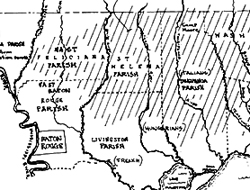Table of Contents
Folk Regions
Three Ethnic Perspectives
Folk Music of the Florida Parishes
People of the Florida Parishes
In Retrospect

The Material Cultural Landscape of the Florida Parishes in Historical Perspective
By Milton B. Newton, Jr.
Introduction
The Florida Parishes, more than any other part of Louisiana, except the old Isle of Orleans, bear the status of a region bounded by historic events. Long traded among several national powers, and briefly an independent nation, the region persists as a distinct segment of the American experience. As such, the Florida Parishes provide citizen and scholar alike a parcel of land and life that can teach us valuable lessons in understanding folk and vernacular landscapes within its historic bounds.
A little less than 5,000 square miles, the area of the Florida Parishes stretches from the thirty-first parallel of latitude to the middle of Lakes Pontchartrain and Maurepas, and from the Mississippi River to the Pearl. Its boundaries, among the oldest in force in the state, include the thirty-first parallel to the middle of the Mississippi, down to the head of Bayou Manchac. There, at the southern edge of East Baton Rouge Parish, the Florida Parishes adjoin what was once part of the Isle of Orleans and is now Ascension Parish and a small portion of Iberville Parish. These two historic districts share a common boundary along the Manchac and lower Amite Rivers, which passes through Lakes Maurepas and Pontchartrain and through the Rigolets into the Lake Borgne-Mississippi Sound area. There it follows the course of the Pearl River to the thirty-first parallel.
The eight Florida Parishes embrace a subtly varying land. From just less than 400 feet elevation along the boundary with the state of Mississippi, the land surface slopes in two general segments to sea level along the boundary with the Isle of Orleans. The division between these two segments lies close to the boundaries between East Feliciana and East Baton Rouge in the west, between St. Helena and Livingston in the middle, and between Washington and St. Tammany in the east. West Feliciana lies in the northern, higher, hillier segment, while Tangipahoa lies in both. The southern tier, thus, has a low, very gently sloping surface, while the northern tier has a hilly, dissected surface. Along the very southern margin of the Florida Parishes, the surface becomes flat and low enough for swamps and even marshes. At the western edge, overlooking the floodplain of the Mississippi, a distinct deposit of "loess" forms the sharply dissected Tunica Hills of West Feliciana and the eastern limit of the Mississippi floodplain (its valley wall) in West Feliciana and East Baton Rouge.
Normally quiet, gentle streams flow generally southward across the Florida Parishes at slopes of six to eight feet per mile. These streams, most notably Thompson Creek, the Amite, and the Tangipahoa Rivers, expose and carry sand and gravel from the red hills of the northern segment. These sands, characteristically white, were made so by having had thin mineral coats worn off by the action of the streams. The gentleness of the streams, together with the sand and gravel in their beds, made possible the building of many historic fords across them. However, the same gentleness limited historic settlers to a few small water-powered mills and limited schooners and steamboats as well to use of only the lower reaches of streams. The Amite, for example, was navigable to Denham Springs; the Tickfaw, to Springfield; and the Tchefuncte, to Covington. The Pearl, like the Mississippi, has always been commercially navigable throughout its length in the Florida Parishes.
The soil of this region has provided different opportunities at different times, depending upon the methods, machines, and markets of the inhabitants. The district that has the greatest natural fertility lies mostly in West Feliciana, with thinner extensions into East Feliciana and East Baton Rouge. During the heyday of the plantation system, this region, having the advantages of both naturally fertile soil and close access to the river and market connections, prospered as a producer of cotton, corn, sugar, and indigo. The most durable agricultural district in the Florida Parishes, however, lies in Washington Parish, where a stable farming community has an unbroken record of nearly two centuries of productivity. A younger farming district lies in Tangipahoa where the north-south railroad provides convenient access to urban markets for milk. The same railroad promoted the establishment of small areas of specialty crops, most notably strawberries in the southern part of Tangipahoa and adjacent Livingston and St. Tammany.
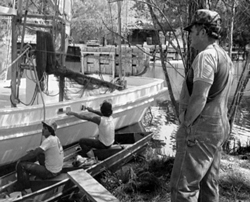
The small rivers of the Florida Parishes have narrow floodplains with parallel strips of fertile land that seldom floods. The narrowness of these small valleys limited the degree of agricultural development during the 19th century. Occasional good markets, and the inherited habit of farming, however, led settlers to extend cultivation, primarily of corn and cotton, into the adjacent hills. The natural infertility of the soil and the practical remoteness of these tracts necessarily limited the success of such hill farms. Many of the settlers, nonetheless, had also inherited a predilection to stock-raising and so, turned to that as a supplementary or even primary mode of living.
The early days of the Florida Parishes can be viewed as a matter of southward flow. The settlers and their products tended to move from north to south, from the hills, along the valleys, to the main market in New Orleans. By the mid-eighteenth century, the connection of the Florida Parishes with New Orleans had become well established, abating only slightly during the twentieth century.
The Main Ethnic Character
Without much chance of contradiction, we can say that the Florida Parishes, insofar as they are known to people outside the region, suffer two inaccurate stereotypes. The more recent of these inappropriate concepts portrays the region as fully part of South Louisiana. While the influence of Latin south Louisiana cultures does play along the edges of the Florida Parishes, the vaster share of the region lies within the influence of British-American culture. The older misconception renders the region as one of entirely Anglo-Saxon culture that in places has a majority of Afro-American population. While the area as a whole falls under the cultural dominance of British-American, white Protestants, none can deny that, particularly since the late 19th century, the Florida Parishes have become home to people whose roots stem from southern and southeast Europe. Even in the earlier period, distinct divergences from the dominant Anglo pattern existed.
The Native-American culture of the region, in part through sparse settlement, fell an easy victim to contact with people from the Old World. New diseases, stemming partly from the interaction of the European and African populations with those of the New World, repeatedly decimated the native population. By the time of permanent white settlement in the Florida Parishes, the ravages of contact had removed nearly all of the Indians. The ones who occupied the region then or shortly afterward were themselves recent immigrants. The current Indian component of the Florida Parishes, primarily Choctaws, are immigrants like the rest.
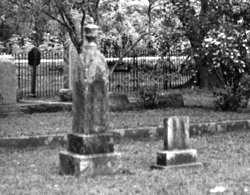
The first Europeans to enter the Florida Parishes, often thought to have been French, were actually British, particularly Scot merchants. They were followed shortly by agricultural settlers who took up plantations along the Manchac, Amite, and Mississippi Rivers, as well as at a few points on Lake Pontchartrain. These planters arrived from Britain or from older British settlements in the Atlantic colonies, especially South Carolina. After the Spanish capture of British West Florida, another British group began a second infiltration into the region, mainly by overland trails from the northeast and east. These people, often called "Upland Southerners" - despite their not being large-scale planters - also brought Black slaves into the area.
These English and Scots-Irish settlers, with their own and their slave labor dominated the region until after Reconstruction. During this period, ethnic diversity within this culturally British area amounted to little more than a small French enclave on the southern edge of Livingston Parish, and a few Irish settlers in St. Helena and Tangipahoa, and a scattering of French, Spanish, Indian, German, and Jewish settlers along the bluffs of the Mississippi, principally in and around Baton Rouge and Bayou Sara (St. Francisville). To keep perspective, however, such a degree of ethnic diversity was, for the early 19th century, fairly remarkable. Only a few rural places in the East could claim a richer mix of populations. The American frontier, which at the turn of the nineteenth century included the Florida Parishes, attracted the energetic people of many areas.
In overview, then, the Florida Parishes should be seen as having undergone a fairly diverse and rapid frontier development from roughly 1770 until 1820. For the next two generations, little new ethnic diversity arrived, while the old diversity became increasingly unified by a common historic experience. From 1880 until about 1920, new elements again entered and gradually established their distinct areas, even as they absorbed much of the antecedent regional Anglo-British culture. Another period from 1920 until 1950 left the region's culture relatively isolated except for Baton Rouge. After 1950, a reinvigorated economy again made the Florida Parishes attractive to settlers, now chiefly on the margins of metropolitan New Orleans--the Northshore--and Baton Rouge. These urban, generally literate people bring us to the point where we now evince an interest in oral traditional culture, and where it is important to avoid quaint, romantic, and picturesque stereotypes to grasp the quotidian character of the actual experiences of the forebears of the Florida Parishes.
Syncretism
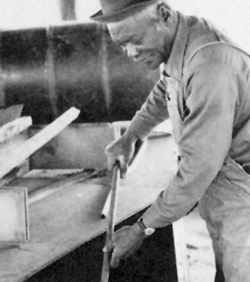
America is a New World, and the American experience is distinct. After a brief period in any place, such as the Florida Parishes, the actual experience of the settlers grew increasingly distinct from that of their Old World forebears. During their passage through this new experience, early settlers carried with them their traditional knowledge and methods for developing family and community living space that speaks of ethnic influence on the cultural landscape. When, however, the settlers have their facilities prepared for them by another, their own preferences have little or no role to play in forming the landscape. The organization and content of plantation quarters, sawmill towns, railroad facilities, company towns, state institutions, and military installations cannot reasonably be expected to reflect, in most cases and in the early days, the influence of ethnic preference. Similarly, as builders increasingly become venture capitalists, building one or many houses in the hope of selling them to people who do not build their own, the role of ethnic preference also decreases.
When we seek to understand the role of folk and vernacular culture in the material culture landscapes of the Florida Parishes, we must always bear in mind that, to the extent that what we see is landscape of institutional/economic control, we are not examining an ethnic landscape. On the other hand, the passage of time may see the residents gradually domesticating pre-set forms to conform to ethnic ideals, either in modifications of the original or in creating new forms based upon a blend of the given and the preferred. At some point in the late 19th century, "box" construction (vertical boards over a nearly stud-less frame) was introduced into the Florida Parishes, probably by the railroads and lumber companies. This mode of construction, new to this region, was gradually adopted by common people and applied to many sorts of buildings, from churches and stores to barns and smokehouses. A different condition is apparent, however, when we examine the fire-insurance maps of, say, Bogalusa and see block after block of shotgun houses of the same size. Here, despite the lack of overt force, is a landscape of control. Company policy, not ethnic preference, dictated the content of the cultural landscape. Much the same can be said for plantation quarters, both before and after Emancipation.
Several processes work during the years to alter the mix of features in the cultural landscape, making both its content and our concept of it change from age to age. Memory is selective. What is retained is only part. What we recall is only part. What we want to recall is only part.
The tolls of time are charged selectively. Some forms of the cultural landscape, which were once common or dominant, are now gone or rare. Consider the complete disappearance of water-powered mills from the Florida Parishes and the near demise of log dogtrot houses. What of turpentine stills, eighteenth-century Creole houses, and ferries? Yet, beside these gaps stand plantation houses, old roads, town plans, and some houses dating from the early 19th century. The most durable element of the material landscape is the cadastre, the system of division of land in relation to the original land grants. Some of the landscape, thus, survives to the present; other parts have been greatly altered or destroyed.
The understanding of what survives, however, depends upon the accurate reconstruction of the parts that no longer survive. An elegant plantation house in East Feliciana cannot be accounted for without reference to the now missing quarters houses of the slaves and tenants and the then current road network and the then current tools of farming; after all, it was the profit of the plantation built on slaves' backs that related resources to markets and made the fashionable elegance possible. The present isolation of the house that once served as a landmark may be accountable to the construction of a railroad that, ironically enough, has also since disappeared. So too for the scattered reflections of a sawmill owner's house; the instigator has vanished, but the imitative neighbors sometimes remain to point to their source.
Not only do time, climate, and technical change play with memory; so do we ourselves. Landscapes of complete or partial economic control, such as railroad and company towns, come gradually to be thought of as "traditional" and "historic," ignoring the thinness of the mantle of politeness that covers their commercial origins. Ethel, Roseland, and Clinton were in fact simple commercial ventures. The slow accumulation of time's patina, together with selective removal of some elements, produces what can all too easily be thought of as a romantic place "where the tradition of the Old South lives on."
The Cultural Strata of the Florida Parishes
Borrowing from the geological model of stratigraphy can help visualize the folklife of the Florida Parishes. In any given spot, the accumulation of cultural patterns may differ from that of another nearby place, depending upon just when each of them received the "deposits" of settlers. In each period, the people who settled in the Florida Parishes had their own distinct cultural preferences and their peculiar technical capabilities, such that different places offered them differing opportunities. Not all parts of the region attracted the same kind of people. As some brief examples show, the kind of settlement depended upon a mix of factors that changed from period to period.
Native-American Tracer
Searching for evidence of Indian culture, native to the Florida Parishes in, say, 1776 leads to virtually no material. Despite a strong desire to find a continuous ethnic presence stemming from prehistoric times, none exists. All Indian culture elements in the Florida Parishes were given to us by Indians who migrated into the region during or after the arrival of the British. The Choctaws, allies of the British, moved into the area with the whites. They readily made war on the Tunica and Biloxi (French allies and also migrants).
Minimal evidence, thus far in hand, suggests that Indian paths cross the Florida Parishes, especially north to south, connecting parts of Mississippi with Lake Pontchartrain and the markets in New Orleans. These trails followed the ridgetops along divides of drainage between the main streams of the area. One such trail, seen to be in use as late as the first decades of this century, runs from Mississippi to the Lake, passing just west of Montpelier in St. Helena. A lumber company property map of the same period shows an enigmatic "Indian Village" at a point in Livingston Parish near the trail. Careful search may reveal other such Indian trails.
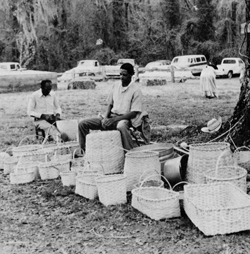
The material culture landscape of the Choctaws who live in various parts of Louisiana, including the eastern Florida Parishes, differs in such small degree from those of their white and Black neighbors that only one who is intimately familiar with them would be able to identify them by sight. Such differences as may exist are further minimized by a large number of Black and white families who are ancestrally and perhaps culturally "part Choctaw." In general, the incoming Upland South culture, before arriving in Louisiana, had already arisen as a blend of European, African, and Indian traits. On balance, the cultural landscape in the Choctaw parts of Washington and St. Tammany looks very much like non-Indian parts of the Florida Parishes.
A French Outpost
French explorers and traders did in fact touch and cross the Florida Parishes; very few French settlers occupied lands in the district. Despite the false lead of "Baton Rouge," however, no persistent French settlement of the Florida Parishes occurred until the Spanish period, when a French enclave was established at French Settlement. At other points, on account of long association of some families with Cajun and Creole kinfolk to the west, there now exist French traces throughout the southern and western parishes. With the increasing cultural ascendancy of South Louisiana, we even see the adoption of French stylistic traits by those who, a scant generation ago, would not have dared to sport such customs. These traits fall mainly in the "pass a good time" categories of food and entertainment.
In French Settlement, the only sizeable, long term French settlement in the Florida Parishes, there survive numerous elements of the built landscape that date from the prosperous period of lumbering from about 1890 to 1920. We should note that even this relatively intact assemblage of houses and barns replaced older, more strictly French types. Using extensively the vertical board building technique that they shared with many Anglo areas at the same time, the people in French Settlement replaced nearly every old building with new ones bought with the flush-times money from lumbering. Old forms were rebuilt with new materials and new techniques.
Scots-English
Using out-of-date geographical intelligence, the British eagerly sought access to the Manchac-Amite route at the end of the French and Indian War in 1763. Feeling, as Iberville had mistakenly also felt, that waterway would provide a reliable access to the interior of North America, the British sought to establish settlements along the southern fringe of the Florida Parishes, with two northward strips along the Mississippi and the Amite. Grants were assigned; some of them were actually settled. When the Spanish invaded in 1779, however, many grants were found to be unoccupied and unimproved. Having thus violated the terms of their grants, many of the grantees were legally dispossessed by Spanish officials, who then could reassign such lands to valid settlers.
The principal aim of British policy was largely determined by the traders whom it served. To gain control of the Indian trade of the Mississippi Valley had long been the goal of British merchants operating originally from Charleston. Many of these men were also planters and ranchers, and as such, they also sought access to the horse and mule supplies of Spanish Texas. Except for serving as spearheads of British expansion, these merchants have left little trace other than a few place-names.
Such merchants who chose also to set up plantations, together with those British subjects who migrated to the Amite and Mississippi originally to found plantations, made a much more lasting British mark upon the landscape of the Florida Parishes. Those who actually settled retained their grants after the Spanish invasion and, thus, left indelible marks upon the land. They contributed to setting up the plantation grounds, and also laid an Episcopalian foundation in West Feliciana.
Both the merchants and the planters aimed their settlements at the avenues of trade. Planters who selected and received naturally fertile lands situated on navigable waterways generally did well, while those whose lands lacked either of these two geographic qualities generally did poorly. Those whose lands lacked both failed. The plantation, like the Indian trader, was a frontier commercial institution that participated in world markets. As such, the plantation received material culture traits directly from the centers of taste and fashion not long after each period of high tobacco and indigo prices. While nothing notable remains standing from the British period, the tone and pace of plantation material culture and landscape were set in a mold that persisted into the 1850s.
Upland South Regional Culture
A great deal of what came from the Old World to America was changed during, or soon after, the passage. Such is certainly the case with what we call the Upland South culture that forms the deepest and widest deposit in the cultural stratigraphy of the Florida Parishes. This mix of traits and people had its origin in the back country of Pennsylvania, Virginia, and the Carolinas, and included contributions from English, Welsh, Scots-Irish, Scots, Germans, Huguenots, Africans, and Indians. They contributed variously and, during the westward migration, their material culture differences generally vanished. The composite culture cannot honestly be said to be Scots-Irish, English, German, or African, but a blend of traits from all those sources.
During the Spanish regime in the Florida Parishes, a folk migration of Upland Southerners rolled across the district. It would have been normal in 1850 to have found families whose immediate corresponding relatives lived in the states from North or South Carolina to Texas or from the Ohio to the Gulf.
If we examine the cultural landscape of the Florida Parishes away from the few large towns and back from the railroads, we still see the impress of the Upland South. Only with diligence will we find relics dating from before 1870, almost none from before 1820. These are evidenced in preferences for single family settlements, scattered houses and outbuildings, casual arrangements of roads and public facilities, houses based on a common "pen" tradition, barns based on a similar "crib" tradition, and a nearly unalloyed evangelical Protestantism.
Many elements have changed, but the style and tone of the traditional Upland South landscape taste persist. One must, however, be able to visualize old tastes expressed in contemporary materials. So too, in each period of history, new materials became domesticated, even as they contributed to changing the material culture landscape.
African Americans
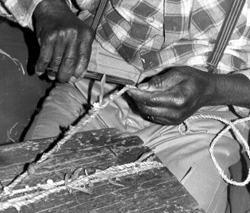
The Black population of the Florida Parishes ranges from less than 15 percent in Livingston to more than 55 percent in St. Helena. Blacks have played a significant role in the historical geography of the area. From virtually the first days of permanent settlement, Blacks contributed to the formation of the material culture of the Florida Parishes.
Most significantly, the dominant cultures of the region are neither strictly European nor strictly African. Just as they are not mere transplants of respective Old World cultures, they are not connected solely to one or the other group in the New World. African material culture was incorporated into the cultural landscape of New World cultures most commonly when it nearly matched some European trait. One of the most important attributes of the Upland South culture, for instance, is that it is not simply European, but a syncretic blend of European, African, and Native-American traits.
The greatest rewards for those who search for strongly African traits will come from examining the old plantation areas in the Felicianas. There, the large number of African immigrants, together with the much greater social distance between Black and white material experience caused by the inequity of the plantation, makes it plausible to seek African material culture traits. Even there, however, surviving Africanisms occur mainly in non-material culture such as music, ritual, and narrative forms.
In the remaining, less affluent parts of the Florida Parishes, the difference in well-being between Blacks and whites was generally less. The forms of material culture used by each group have continuously been quite similar. One cannot without prior knowledge of the persons living on any one farmstead say with certainty which race lives there. Certainly, one would not be mistaken to assume that Blacks generally or often live on less affluent farms. Too many contradictory cases can occur to make such inference safe. The form (type) especially does not differ significantly between the races.
The material culture landscape does, however, record with fair reliability the fact of disadvantage in social, political, and economic matters for Black West Floridians. In terms of material culture, these disadvantages had the effect of slowing the adoption of new forms that require large investment. Thus, the Black builder responsible for many a stylish house generally built these for whites. Unlike clothing and similar inexpensive items, currently fashionable houses either cost too much or made the owner vulnerable to hostility from dominant whites.
One important way that disadvantage gained expression in the material landscape was through the credit market. Few Blacks would willingly enter a debt relationship for large sums, even when they had the money. One clear example lies in the differential adoption of dairying in the Florida Parishes. Despite the efforts of farm demonstration agents and despite government-sponsored loan programs, almost no Blacks chose to try to become dairymen. Most simply did not want to risk what land they owned by placing it under mortgages. Instead, those ready to leave the row-crop farming of cotton chose stockraising. Ironically, the material culture landscape records this aspect of disadvantage in a vast number of abandoned, small dairy barns--virtually all on white farms that now specialize in stockraising.
The Americanization of the Florida Parishes
Common elements on the regional landscape can be primarily viewed within the framework of the sudden, rapid spread of the American frontier, largely the culture of the Upland South, across a million square miles of the eastern United States, largely during the period from 1775 to 1845. The Americanization of the Florida Parishes was at first the introduction of the Upland South into the area; the nationalization, the emergence of the region from Reconstruction into the ways of the modern, industrial world.
Scarcely had Upland South settlement spread over the region for a generation when the Civil War, Emancipation, and Reconstruction swept with even more fury over the land. From 1810 to 1860, the pattern was implanted; from 1860 to 1880, it was overhauled. Many parts of the Florida Parishes remained in the pioneer stage of log construction when the War and its consequences raked the area. The fragility of what went before and the destruction of war readily appear in the paucity of standing structures that date from before 1880. Such old houses and barns do indeed survive, but few relative to the number that existed in say 1855. Most of what is "old" in the region today dates from between 1880 and 1920, the period of nationalization of the Florida Parishes.
The upheaval of the 1860s brought two main consequences for the material culture landscape: a sharp increase in the number of households and a severe decline in the supporting structures of agriculture. The emancipation of the slaves, in terms of material culture landscape, brought the increase in the number of farmsteads, effected in the parts of the Florida Parishes outside the Felicianas. With this increase, there arose the need for a larger number of houses, barns, smokehouses, mules, cattle, and so forth through the entire list of material culture items. At the same time, the region had undergone the exactions of both Union and Confederate armies in their requisitioning of supplies, the most burdensome being the loss of livestock. Just when more livestock were needed, the available stock of animals to work and feed the region had been sharply reduced.
The resulting poverty for Blacks and whites in most of the region endured until the beginning of industrial lumbering after about 1880. The onset of this new invasion took place first in St. Tammany, and spread through the pine lands to the west and north. The effect was to make possible for the first time since before the War a general prosperity--at least a prosperity relative to the recent past. People were able now to find new money that would satisfy a long held craving for renovation of their material conditions.
With the new steam engines and the new people from the North and East, came a new awareness of the nation as a whole. Not that nationalization of the Florida Parishes gained immediate or complete sentimental acceptance; rather, the fashionable products of the nationally emerging popular culture gained the affections of the people. Not only did money appear to purchase fashion, but mass media models indicated the styles that should absorb the new money. Magazines, mail service, and catalogues arrived on numerous big and small railroads, that by 1900 had extended their iron fingers across the area. A generation of ferment from about 1890 to about 1920 formed a new stratum upon the two previous periods of extensive change, namely the ante-bellum immigration and Civil War Reconstruction.
The effect that stands out for material culture is one of incorporation of the Florida Parishes into national trends, matched by the reinterpretation of these trends in terms of local patterns. New building techniques served old house plans. New styles and plans found distinctive expression in heart pine and cypress. Newly available horticultural material found uses in old garden concepts. The Great September Storm, a severe hurricane of 1909, felled untold millions of board feet of timber, spurring the entry of lumber companies and the associated "dummy lines" (small industrial railroads) as they rushed to salvage the timber before it was lost to usefulness. Landowners gladly cooperated with the removal of the timber, often taking part of their pay in cut lumber. There resulted a spate of construction made possible by both the available timber and the money from wages and sales. As always, the renovation of the landscape relied upon the contemporary fashions, now more clearly understood from the popular media that had already gained circulation.
The coming of railroads to the Florida Parishes introduced yet another novelty, new at least in its degree of impact. The railroad companies either directly or indirectly promoted the establishment of a large number of towns, villages, and hamlets that were planned, platted, and laid out before any settlers took up lots. More than fifty planned settlement agglomerations were built in connection with railroads, sawmills, or both. These planned settlements soon overwhelmed the mere eleven towns that antedated such sweeping renovation.
Some of these planned towns appeared in the effort to build an "iron Mississippi" from Chicago to New Orleans (Hammond, Amite, Kentwood, Zachary), while others from that same effort have languished (Wilson, Ethel, Tangipahoa, Fluker, Tickfaw). Those new large cities revived as dormitories for the larger places (Baker, Slidell, Pearl River). A comparable pattern appears along the east-west route from Baton Rouge toward Mobile (Walker, Robert, Holden, Goodbee). Less well known are the smaller lines, such as those that penetrated St. Helena. Their little towns remain long after the last tie has rotted as a fencepost (Montpelier, Pine Grove, Grangeville).
In all of these instances and more, the original role of the railroad has long since changed, but the effects of its coming and going remain. In the very plans of the towns and villages, so common as to be taken as "normal" and therefore unremarkable, the railroad remains the overbearing factor accounting for historic material culture. Not only in the location of the town for the convenience of the trains and the placing of the track in the middle of the town, but also in the specific styles of architecture, the specific industrial and domestic appliances, the design concept seen in the town cemetery, the naming of streets, and so forth, the gripping fingers of railroad-related "traditions" appear.
Beyond these rather obvious consequences of the pre-organized settlements of the railroads and the lumber companies, are two direct consequences. First, the companies, seeking to fill their planned settlements, promoted the entry of new ethnic groups into the Florida Parishes, most notably Italians in southern Tangipahoa and Hungarians in eastern Livingston and southern Tangipahoa. New churches and fraternal halls, as well as new kinds of retail establishments, mark the areas of Italian settlement. Persistent small farming and two new churches still attest to the Hungarian entry. Both of these groups have been absorbed in part into the regional pattern, while adding some cultural distinctiveness to the area. They often have altered the public manifestation of their heritage to food, music, and an annual festival.
The second additional direct effect can be seen in the emergence of ethnic neighborhoods in the new pre-organized settlements. The railroad and the main cross highway quartered these new towns. More often than not, these four quarters came to be assigned to or associated with different groups such that one area held Blacks, another white Anglo-Saxons, another Italians or Hungarians. In another town, the white Anglos held three quarters, while the Blacks had one. Whatever the local pattern, the railroad town contrasts sharply with the original eleven towns, which were entirely white because they date from before Emancipation.
The coming of the railroads, then, saw the introduction of the modern age into the Florida Parishes. Now, specialization, ethnic neighborhoods, ethnic complexity, subdivisions, tract housing, nationally faddish styles, and other such elements familiar to us today gained increasing sway in the cultural landscape of the area. The twilight of historic traditions had begun. By World War II, even those remnants of old national culture had become thought of as being "traditional."
Conclusion
The Florida Parishes, rich in people and traditions, if not in land, form a region, primarily because of quirks of political history and geography, rather than a cultural pattern fully separate from other areas. Yet, they provide an area worth considering in their own right, and as a demonstration area for processes such as diffusion, syncretism, and acculturation that work to similar ends in other places.


